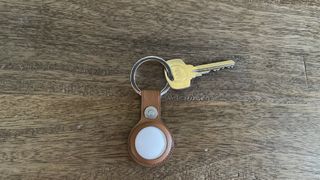I lost my AirTag and it was found within 30 minutes - but Tile took a whole day
We put Air Tag and Tile head-to-head to discover which keyfinder was easiest to locate

A key finder like Apple’s AirTag or rival Tile, can make the frustration of temporarily misplacing your keys, wallet, bag, or any other possession, a thing of the past.
These small devices, also known as location trackers, can be attached to your possessions - then if you can’t remember where you left the item, you can use an app on your smartphone to make the key finder emit a noise, making it easier to locate it.
But what happens if your phone is too far from the key finder? Both Apple and Tile pride themselves on their community of users (those with the Tile app or a recently-updated iPhone) that can anonymously update your key finder’s location if they happen to pass by it.
OK, that sounds great - but how fast will you really be able to find each of them? After all, Apple has a potential user base of 1.65 billion and Tile currently has 36 million users, so which will actually help you find your treasured possessions as quickly as possible? ,
We decided to find out by deliberately leaving an AirTag and a Tile out of range of our smartphone, timing how long it took each to be discovered by other users. The AirTag has the user base, but Tile is the more entrenched solution - so which would be found first?
- Still not convinced? Read Apple AirTag vs Tile for a full comparison between the two key finders
- Find out how to use AirTags with iOS 14.5
- After AirTags launch, Tile to ask Congress to look into Apple over antitrust concerns
Time is of the essence
Around 9am one Monday morning, we placed both an Apple AirTag and a Tile Mate behind a street sign on a busy thoroughfare, around one mile from our home. We then returned home, marked both key finders as lost in their respective apps on our iPhone, started a stopwatch and waited.
Within just 30 minutes, a notification popped up with the location for the lost AirTag as it had been identified by a passing iPhone, although the location given was the road that runs parallel to where we’d originally placed it, even though it was still in the original spot.
Get daily insight, inspiration and deals in your inbox
Get the hottest deals available in your inbox plus news, reviews, opinion, analysis and more from the TechRadar team.
Throughout the day, the same ‘wrong’ location was confirmed 13 different times, and the AirTag remained where we placed it. However, the Precision Finding feature, which uses uses Ultra Wideband radio technology to identify the distance and direction your iPhone is from the AirTag, makes this less on an issue as directions and a distance counter on screen can help you find its exact position if it’s not immediately obvious.
However, it took almost 12 hours before someone from the Tile community was able to detect the Tile Mate and provide us with a notification on where it was hiding.
The key finder was still in its original location, although the ‘community update’ that came in placed it a few meters from that spot, although this was closer than where we were told the lost AirTag was residing.
So are AirTags really better?
It’s pretty clear to see that, if you are out of range of your keyfinder, you’re likely to be reunited quicker with an AirTag than a Tile tracker, but that’s because of the size of the communities in the area we tested it in.
To detect an AirTag, an iPhone or iPad needs to be running iOS 14.5 - the most recent version of the operating system - and have the Find My iPhone feature turned on.
Apple won’t disclose just how many devices that applies too, but considering in January this year Tim Cook revealed there were 1.65 billion Apple devices in active use and 80% of those run iOS 14, that makes for a very large potential community. However, to locate an AirTag, an iPhone needs to be running the latest version, iOS 14.5, which is still being rolled out so this figure could increase further.
If you use the Tile app, you can see the number of community users near you, and for our location that ranges from 789 to 1,500 depending on the time and day, which theoretically is considerably less than the Find My network.
You can sign-up to the Tile app and see how many community members in your area even if you haven’t purchased a Tile key finder, which is worth doing before you decide which one to plump for.
But before you decide the above means you're going to rush out and buy an AirTag, it’s worth noting that Tile does offer some big benefits.
AirTags only work with iPhones, so if you have an Android device, you’ll have to opt for Tile. They also come in a range of different styles; Tile Mate and Tile Pro can be attached to keys, Tile Slim is a credit card shaped device for your wallet, and Tile Sticker, which has an adhesive pad so it can be attached to everything from lunch boxes to a remote.
Tile is also more affordable, as you can pick the version that suits the item you want to attach it to, however AirTags on come in one design that doesn’t have a loop or adhesive backing. So if you want to attach it to keys or another item rather than slip it into a bag or wallet, you’ll need to purchase optional accessories like key fobs, which cost the same amount, or in some cases more, as the AirTag itself.
It’s worth pointing out that AirTags and Tile don’t have GPS built-in, so its exact position isn’t constantly being updated. Instead, location updates rely on an iPhone running iOS 14.5 being in close range, so while that’s great for busy town centers, you’ll struggle in deserted areas - as YouTuber AirTagAlex found out when he mailed an AirTag back to himself to track it’s journey.
Today's best key finder deals
- Check out these great iPhone deals
Carrie-Ann Skinner was formerly Homes Editor at TechRadar, and has more than two decades of experience in both online and print journalism, with 13 years of that spent covering all-things tech. Carrie specializes in smart home devices such as smart plugs and smart lights, as well as large and small appliances including vacuum cleaners, air fryers, stand mixers, and coffee machines. Carrie is now a copy editor at PWC.
Most Popular


